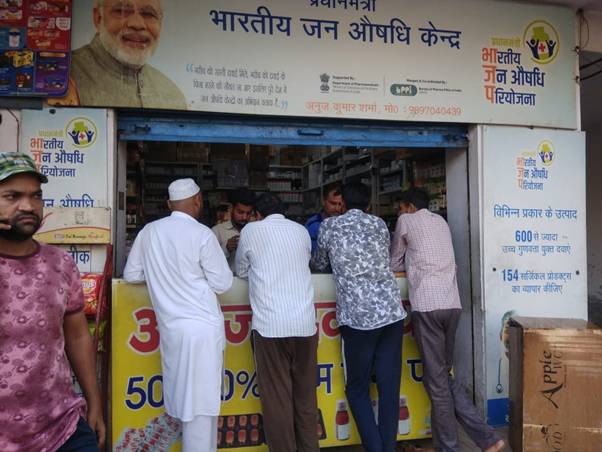The Pradhan Mantri Bharatiya Janaushadhi Pariyojana (PMBJP) is a flagship initiative of the Government of India aimed at making quality medicines available to all at affordable prices. Launched by the Department of Pharmaceuticals under the Ministry of Chemicals and Fertilizers, the scheme seeks to reduce out-of-pocket healthcare expenses for citizens, particularly the economically disadvantaged, by promoting the use of generic medicines through a network of dedicated outlets known as Jan Aushadhi Kendras.
Origins and Evolution
The concept of providing affordable generic medicines was first introduced in 2008 under the name Jan Aushadhi Scheme, with the establishment of the first Jan Aushadhi Kendra in Amritsar, Punjab. However, it was restructured and rebranded as the Pradhan Mantri Bharatiya Janaushadhi Pariyojana in 2015 under the leadership of Prime Minister Narendra Modi, giving it a renewed focus and wider reach. The scheme has since expanded significantly, aligning with the government’s broader vision of accessible and affordable healthcare for all.
Objectives of PMBJP
The PMBJP has several key goals:
- Affordable Healthcare: Provide high-quality generic medicines at prices significantly lower than branded alternatives, often at 50-90% less cost.
- Promote Generic Medicines: Raise awareness about the efficacy and safety of generic drugs, which contain the same active ingredients as branded medicines but are sold under their chemical names.
- Reduce Healthcare Costs: Alleviate the financial burden on patients, especially those with chronic illnesses requiring long-term medication.
- Ensure Quality: Guarantee that medicines meet stringent quality standards set by regulatory authorities.
- Widespread Availability: Establish a robust network of Jan Aushadhi Kendras across urban and rural areas to ensure easy access.
Also Read: 10 Government Health Schemes Offering Free Medical Care in India
How Pradhan Mantri Bharatiya Janaushadhi Pariyojana (PMBJP) Works?
Jan Aushadhi Kendras:
These are retail outlets set up under the scheme to sell generic medicines, surgical items, and other healthcare products. They can be opened by individuals, NGOs, trusts, hospitals, or state governments with support from the government.
Procurement:
Medicines are sourced directly from manufacturers by the Bureau of Pharma PSUs of India (BPPI), the implementing agency for PMBJP. This eliminates middlemen, keeping costs low.
Product Range:
Over 1,800 medicines and 285 surgical items are currently available under the scheme, covering a wide range of therapeutic categories such as diabetes, hypertension, pain management, and infections.
Quality Assurance:
All drugs are tested in laboratories accredited by the National Accreditation Board for Testing and Calibration Laboratories (NABL) to ensure they meet Indian Pharmacopoeia and WHO standards.
Key Features
Pricing: Medicines are priced uniformly across all Jan Aushadhi Kendras, making them affordable compared to market rates. For example, a strip of paracetamol that might cost ₹30 in the open market is available for as little as ₹5-10 at a Kendra.
Accessibility: As of early 2025, over 10,000 Jan Aushadhi Kendras are operational across India, with a target to reach 25,000 in the coming years. These centers are spread across districts, including rural and underserved areas.
Incentives for Operators: Private entrepreneurs opening Kendras receive financial assistance of up to ₹5 lakh, along with a 20% margin on sales, encouraging participation in the scheme.
Integration with Healthcare: State governments and public hospitals, like those in Delhi, are increasingly partnering with PMBJP to procure medicines and establish Kendras within hospital premises.
Impact of Pradhan Mantri Bharatiya Janaushadhi Pariyojana (PMBJP)
- Cost Savings: The scheme has saved Indian citizens billions of rupees annually by offering affordable alternatives to expensive branded drugs.
- Health Equity: It has made essential medicines accessible to low-income families, reducing disparities in healthcare access.
- Employment Generation: The expansion of Jan Aushadhi Kendras has created job opportunities for entrepreneurs, pharmacists, and support staff.
- Public Awareness: Campaigns under PMBJP have helped dispel myths about generic medicines, boosting their acceptance.
Also Read: Branded Medicines and Generic Medicines: Major Differences You Need to Know
Recent Developments of PMBJP
As of March 27, 2025, the scheme continues to grow. For instance, the Delhi government recently mandated that its hospitals procure medicines from PMBJK and approved the setup of Kendras in six hospitals, with plans for further expansion. Such integrations reflect the scheme’s increasing role in public healthcare systems. Additionally, the product basket is being expanded to include more over-the-counter (OTC) products, nutritional supplements, and Ayurvedic medicines.

Challenges
Despite its success, PMBJP faces hurdles:
- Awareness: Many people still equate low cost with low quality, necessitating continuous education efforts.
- Supply Chain: Ensuring a consistent supply of medicines to all Kendras, especially in remote areas, remains a logistical challenge.
- Competition: Resistance from private pharmacies and pharmaceutical companies selling branded drugs poses a barrier to wider adoption.
Future Vision
The government aims to make PMBJP a cornerstone of India’s healthcare framework by expanding the network of Kendras, diversifying the product range, and leveraging technology for online access and home delivery. The ultimate goal is to ensure that no Indian is denied essential medicines due to financial constraints.
In summary, the Pradhan Mantri Bharatiya Janaushadhi Pariyojana is a transformative initiative that combines affordability, quality, and accessibility, making it a vital tool in India’s journey toward universal healthcare.
Image Courtesy: PIB – GOV




